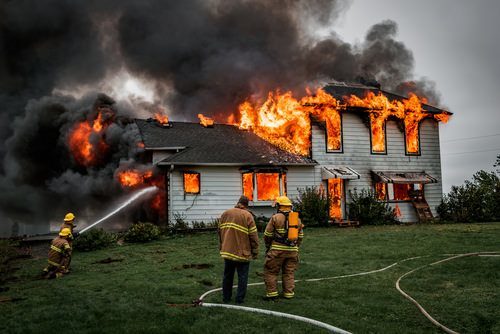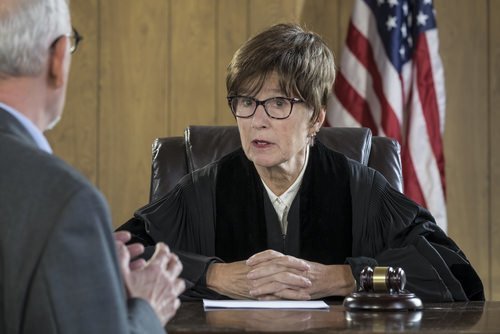Under Colorado CRS § 18-4-102, first-degree arson is when you burn a building or occupied structure owned by someone else without the owner’s consent. Arson of an occupied structure is a class 3 felony punishable by 4 to 12 years in prison and a minimum fine of $3,000. Arson of a building is a class 4 felony punishable by 2 to 6 years in prison and a minimum fine $2,000.1
The language of the statute reads:
(1) A person who knowingly sets fire to, burns, causes to be burned, or by the use of any explosive damages or destroys, or causes to be damaged or destroyed, any building or occupied structure of another without his consent commits first degree arson.
(2) First degree arson is a class 3 felony if the arson is of an occupied structure, and it is a class 4 felony if the arson is of a building.
(3) A defendant convicted of committing first degree arson by the use of any explosive shall be sentenced by the court in accordance with the provisions of section 18-1.3-406 .
There are 4 degrees of arson total (from most serious to least serious):
|
Colorado arson crime |
Penalties (generally) |
| First degree (CRS 18-4-102): knowingly damaging someone else’s building or occupied structure with fire or explosives. | Of an occupied structure: Class 3 felony: 4 to 12 years in prison and/or $3,000 to $750,000
Of a building: Class 4 felony: 2 to 6 years in prison and/or $2,000 to $500,000 |
| Second degree (CRS 18-4-103): burning a building or occupied structure without the owner’s consent. | A felony, misdemeanor, or petty offense depending on the value of the endangered property |
| Third degree (CRS 18-4-104): setting fire in order to defraud someone. | Class 5 felony: 1 to 3 years in prison and/or $2,000 to $500,000 |
| Fourth degree (CRS 18-4-105): endangering someone else or their property by setting a fire. |
If someone is endangered Class 4 felony: 2 to 6 years in prison and/or $1,000 to $100,000 If no one is endangered A felony, misdemeanor, or petty offense depending on the value of the endangered property |
You could also have to pay the victim restitution for the property damage.
Examples
- Seeing that Grace is at home, Toby slips a pipe bomb through the letter slot in her front door and it explodes.
- George and Sarah set a fire as they leave work.2
Legal defenses
There are several legal defenses for people who have been accused of arson in the first degree. Some of the most common include:
- You were not the one who set the fire,
- The fire was an accident, and
- The owner consented to the fire.
In this article, our Denver Colorado criminal defense attorneys will explain:
- 1. What is first-degree arson under CRS 18-4-102?
- 2. Legal defenses to arson in the first degree
- 3. Penalties for a conviction for first-degree arson in Colorado
- 4. Related offenses to first-degree arson under CRS 18-4-102
- Additional resources

First degree arson is a class 3 felony under Colorado criminal law.
1. What is first-degree arson under CRS 18-4-102?
In Colorado, first-degree arson is defined in CRS 18-4-102. This section prohibits knowingly setting a fire or explosion that damages someone else’s building or occupied structure. That building has to be owned by someone else. The arson has to be done without that person’s consent.
The crucial factors that make arson a first-degree arson are:
- Someone else owns the building,
- You set fire to a “building or occupied structure,” and
- The fire or explosion damaged the building.
1.1. What does it mean to “own” a building under CRS 18-4-102?
You commit first-degree arson if you set fire to someone else’s building.
An owner under CRS 18-4-102 is anyone else with a possessory or a proprietary interest in the building.3 This means you can be liable for first-degree arson if you set fire to the following buildings:
- A building you are renting,4 or
- A residence that still has a bank mortgage or security interest on it.5
1.2. What is a “building or occupied structure”?
First-degree arson convictions require proof that you set fire to someone else’s “building or occupied structure.”
A building is something that was designed to house people or animals, or to store property.6 Someone does not have to be inside the building at the time of the offense. Buildings under CRS 18-4-102 include a:
- Residence,
- Garage,
- Ship,
- A truck’s trailer,7
- Sleeping car,
- Airplane, or
- Mobile home.8
An occupied structure is an area or enclosure which people or animals can use.9 They can include:
- An outdoor dog kennel,10
- A campground,
- A tent, or
- An occupied car.
However, “occupied structures” do have actually to be occupied at the time of the arson offense. You also have to know that someone is in the “occupied structure” to commit arson in the first degree.
1.3. How badly does the building have to be damaged?
You have to damage or destroy someone else’s property. Merely scorching or discoloring a building with a fire or explosion is not enough.11 However, burning the building to the ground is unnecessary.12 Instead, the materials composing the structure have to ignite or change.13

Violating Colorado arson laws can carry hefty prison sentences.
2. Legal defenses to arson in the first degree
Legal defenses can combat a charge of first-degree arson. The most common legal defenses to a charge under CRS 18-4-102 are:
- It was not you who set the fire,
- You did not knowingly set the fire, and
- The owner consented.
(A potential defense for farmers is that the fire was a controlled agricultural burn.)
2.1. Mistaken identity: It was not you who set the fire
Prosecutors have to prove that it was you who committed first-degree arson. They have to prove this beyond a reasonable doubt. If you can present evidence that it was not you, it can fight an arson charge.
This is the mistaken identity defense.
2.2. You did not knowingly set the fire
First-degree arson requires the fire or explosion was knowingly set. You can defend against an arson charge under CRS 18-4-102 with evidence that you did not act knowingly. If you were acting recklessly or negligently, you cannot be held liable for first-degree arson.
2.3. The owner of the property consented
If the property owner consented to being set ablaze, you cannot be held liable for arson.
However, CRS 18-4-102 recognizes a broad concept of ownership of property. If someone else has any possessory or proprietary interest in the property, they also own it. You would have to have their consent, as well.
3. Penalties for a conviction for first-degree arson in Colorado
First-degree arson of an occupied structure under CRS 18-4-102 is a Class 3 felony. The penalties of a conviction usually include:
- 4 to 12 years in prison, and
- A minimum of $3,000 in fines.
First-degree arson of a building is a class 4 felony. The penalties include:
- 2 to 6 years in prison, and
- A minimum of $2,000 in fines.
First-degree arson offenses in Colorado that use explosives and cause serious injury can face a sentence enhancement. This makes the offense a “crime of violence.”14 Convictions carry between 10 and 32 years in jail.
Additionally, you could have to pay victim restitution for the value of the property.
4. Related offenses to first-degree arson under CRS 18-4-102
Some crimes in Colorado are related to first-degree arson. Some of these offenses are charged alongside arson under CRS 18-4-102. Some others have similar elements to arson:
- Second-degree arson (CRS 18-4-103). Arson in the second degree does not involve a building or occupied structure.
- Third-degree arson (CRS 18-4-104). This type of arson involves setting fire to property to defraud someone.
- Criminal mischief (CRS 18-4-501). This is the crime of damaging someone else’s property. It is a lesser-included offense of first-degree arson.15 Criminal mischief can be a felony or a misdemeanor.
Additional Resources
For more in-depth information on arson laws, refer to these scholarly articles:
- The Evolution of Fire Investigation and its Impact on Arson Cases – Criminal Justice.
- The Metamorphosis of the Law of Arson – Missouri Law Review.
- Assessment, Treatment and Sentencing of Arson Offenders: An Overview – Psychiatry, Psychology, and Law.
- Legal Aspects of Arson – Journal of Criminal Law, Criminology & Police Science.
- The Crime of Arson – Journal of Criminal Law & Criminology.
Legal References:
- See Lipschitz v. People, 53 P. 1111 (1898). HB 23-1293.
- People v. Calvaresi, 600 P.2d 57 (Colo. 1979).
- C.R.S. § 18-4-101(3).
- People v. Brown, 622 P.2d 573 (Colo. App. 1980).
- People ex rel. VanMeveren v. District Court, 619 P.2d 494 (Colo. 1980).
- C.R.S. § 18-4-101(1).
- People v. Simien, 671 P.2d 1021 (Colo. App. 1983).
- People ex rel. VanMeveren v. District Court, Supra.
- C.R.S. § 18-4-101(1).
- People v. Moyer, 635 P.2d 553 (Colo. 1981).
- People v. LeFebre, 546 P.2d 952 (Colo. 1976).
- People v. LeFebre, Supra.
- People v. LeFebre, Supra.
- Colorado Revised Statute § 18-1.3-406(2)(a).
- People v. Welborne, 2018 COA 127 (Colo. App. 2018).
